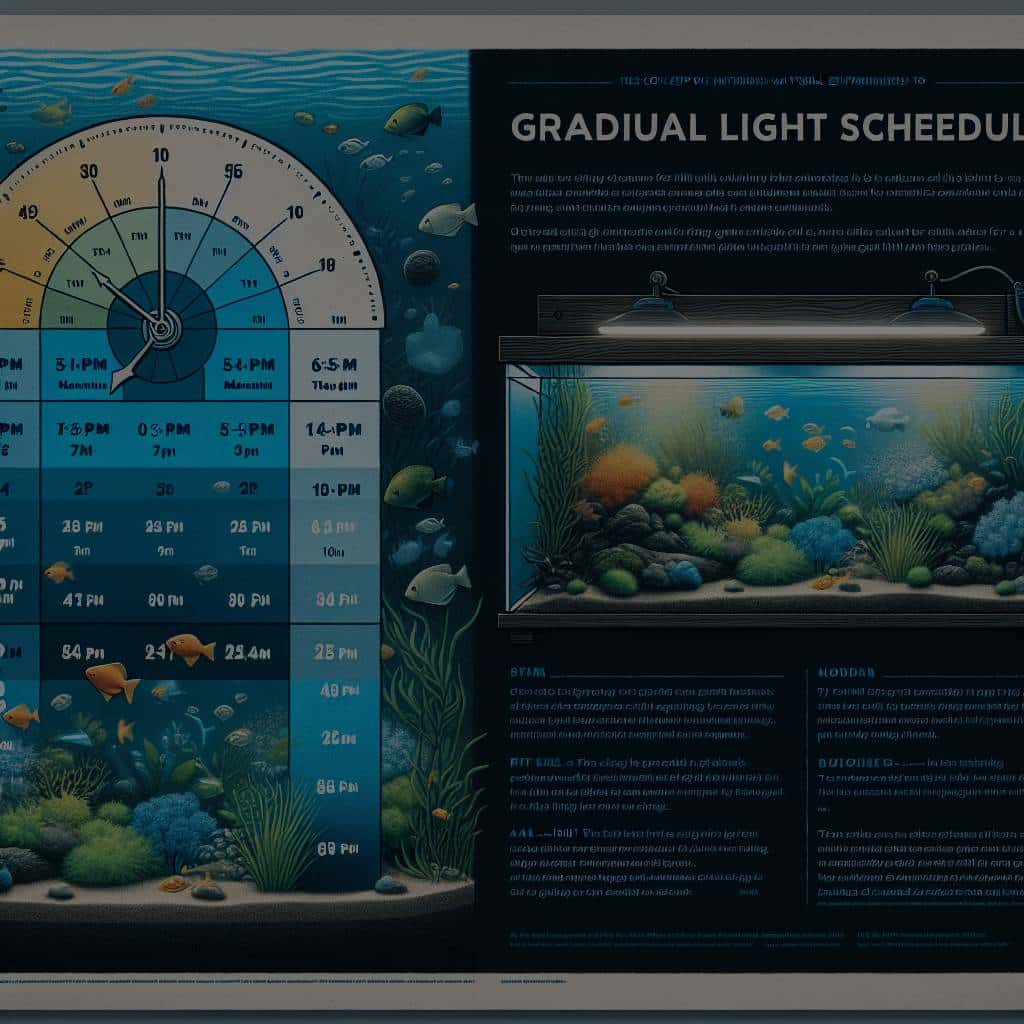Aquariums are magnificent displays of art and ecology, bringing a piece of the underwater world into our homes. The aquarium is more than just a home for fish; it is a carefully curated environment that requires attention to detail, including lighting. This article aims to guide you on how to implement a gradual light schedule for your aquarium that mimics the natural environments of your aquatic pets and plants.
1. Understanding the Importance of Aquarium Lighting
Let’s begin by understanding why lighting is so important in an aquarium.
Also to discover : What Are the Key Considerations When Choosing a Pet for a Small Apartment?
Lighting is more than just a decorative feature that makes your aquarium look attractive. It plays a crucial role in maintaining the health of your aquarium’s inhabitants. For fish, proper lighting simulates the natural day-night cycle, which helps establish regular eating and breeding patterns. For plants, lighting provides the energy needed for photosynthesis, promoting growth and health.
The color spectrum of your aquarium lights can also influence the appearance and behavior of your fish. Different fish species are adapted to different lighting conditions in their natural habitats. The right color spectrum can bring out the vibrant colors of your fish, making them more comfortable and less stressed in their artificial environment.
Also to discover : How to Teach a Dog to Alert to a Specific Sound or Alarm?
2. Choosing the Right Light for Your Aquarium
Now that we are clear on the importance of lighting, let’s move on to choosing the right light for your aquarium.
There are various types of lights available for aquariums, including fluorescent, compact fluorescent, metal halide, and LED lights. Among these, LED lights are the most popular due to their energy efficiency and long lifespan. They also offer a wide range of color temperatures, which helps recreate the natural light conditions in an aquatic environment.
When selecting a light for your aquarium, consider the needs of your fish and plants. Certain fish species prefer dimmer light, while others may require bright light. Similarly, different plant species require different light intensities for photosynthesis. Remember to also consider the depth of your tank, as light intensity decreases with depth.
3. Setting Up a Gradual Light Schedule
Once you have chosen the right light for your aquarium, it’s time to set up a gradual light schedule that mimics the natural environment.
In nature, the intensity of sunlight varies throughout the day. It’s not an abrupt transition from darkness to bright light, and vice versa. To recreate this natural condition, you can use a timer to gradually increase and decrease the light intensity in your aquarium. This gradual transition will help prevent stress in your fish and allow your plants to adapt to the changing light conditions.
The exact light schedule will depend on the specific needs of your fish and plants. However, a common practice is to have a 12-hour light and 12-hour dark period. This can be adjusted according to the season, with longer light periods in summer and shorter ones in winter.
4. Monitoring and Adjusting Your Light Schedule
Setting up a light schedule is not a one-time task. It requires regular monitoring and adjustments to ensure it continues to meet the needs of your fish and plants.
Keep a close eye on your fish and plants for any signs of stress or poor health. If your fish are less active or your plants are not growing well, it may indicate that the light intensity or duration is not suitable. In such cases, adjust your light schedule accordingly.
You may also need to adjust your light schedule based on changes in your aquarium, such as the addition of new fish or plants. Be mindful of the changes in your aquarium’s environment and make necessary adjustments to your light schedule.
5. Other Factors to Consider
Besides lighting, there are other factors that influence the health and well-being of your aquarium’s inhabitants.
Water quality is one of the most critical factors. Ensure that your aquarium’s water is clean and has the right pH, hardness, and temperature. Regular water changes and the use of a good filtration system will help maintain good water quality.
Substrate is another important aspect of an aquarium. The right substrate can enhance the growth of plants and provide a suitable habitat for your fish. Choose a substrate that is suitable for the species you are keeping in your aquarium.
In conclusion, implementing a gradual light schedule for your aquarium can significantly enhance the health and vibrancy of your fish and plants. It’s all about mimicking the natural environments as closely as possible to provide a comfortable and thriving habitat for your aquatic pets and plants. Remember to monitor and adjust your light schedule regularly to cater to the specific needs of your aquarium’s inhabitants.
6. Importance of LED Lights in Replicating Natural Lighting
LED lights are often the preferred choice for aquarium lighting due to their energy efficiency, longevity, and ability to mimic the color spectrum found in natural habitats. LED lights are capable of producing a wide range of color temperatures, making it easier to recreate a diverse range of aquatic environments.
For instance, if your aquarium houses species from a tropical river, you would need to mimic a warmer, softer light that is found in such environments. LED lights can be adjusted to emit this type of light, making your fish feel like they are in their natural habitat. This lessens the stress on the fish, allowing them to display their natural behaviors and vibrant colors.
LED lights also benefit the plants in your aquarium. They can provide the intense light required by certain aquatic plants for photosynthesis. Remember, different plants have different light needs, and thanks to the versatility of LED lights, you can adjust the light intensity to cater to the needs of various plants.
The gradual light schedule, which we touched on earlier, is also easier to implement with LED lights. They can be connected to a timer that can be programmed to gradually increase and decrease the light intensity, mimicking the sunrise and sunset in the natural world.
7. The Role of Nature Style in Aquariums
Incorporating a nature style approach to your aquarium design goes beyond just the lighting. It involves creating an environment that closely mimics the natural habitats of your aquarium’s inhabitants. This includes considerations for the substrate, water parameters, and the types of plants and decorations used.
For instance, the substrate used in your aquarium can greatly impact its overall aesthetic and the health of your fish and plants. Different substrates have different properties, some of which are necessary for certain species. For example, some species of aquatic plants need a nutrient-rich substrate to thrive. Similarly, some fish species prefer sand over gravel as it closely resembles their natural habitat.
Water parameters such as pH, temperature, and hardness need to be closely monitored and adjusted as needed to mimic the natural water conditions of your fish’s and plant’s native habitats.
The decorations you choose to include in your aquarium, such as rocks, driftwood, and plants, should also reflect the natural environment of your aquarium species. This not only enhances the beauty of your aquarium but also provides your fish with a more comfortable and stress-free environment.
8. Conclusion
In essence, replicating the natural lighting and environment in your aquarium is not just about aesthetics, but also about ensuring the health and well-being of your fish and plants. Integrating a gradual light schedule, choosing LED lights, and adopting a nature style in your aquarium design all contribute towards achieving this goal.
While maintaining an aquarium might seem overwhelming at first, remember that it is a process of learning and adjusting. Monitor your aquarium regularly, make necessary adjustments, and don’t hesitate to seek advice when needed.
With patience and effort, you’ll create a thriving aquatic home that brings joy not just to its inhabitants, but also to you as you watch your colorful, tranquil underwater world come to life.











